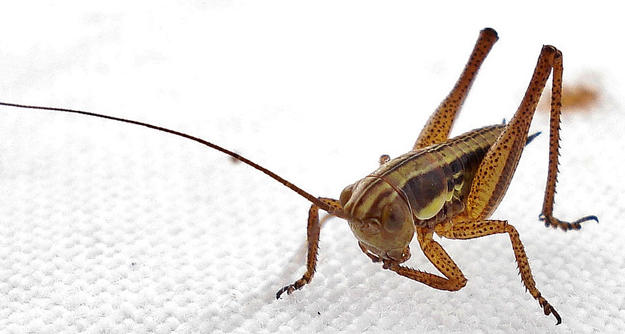Here Come the Crickets!
By Chris Williams on October 23, 2013.

At this time every year, we witness a cricket migration – from outside to inside. The cooler weather of fall sends crickets looking for places to spend the winter. They say that the worst cricket years occur when hot, dry weather is followed by late season rainfall. But of course, whether or not you consider it a bad cricket year depends solely on what is happening around your own home.
Crickets will almost always be entering your home on the ground or basement level where they find openings around doors, window wells, pipes, unscreened vents, etc. Once inside, they usually stay on this lower level in dark areas where humidity is higher, or in areas with water like laundry rooms, near sump pumps, floor drains, and bathrooms.
Crickets can do some damage indoors. They will feed on garbage or on any people or pet foods they find. But they can also damage fabrics, paper, leather, and rubber – usually when these items have been soiled by food, sweat, urine, or other organic materials.
As you probably know, once a cricket gets into your home, it is really difficult to find. Even trying to follow that elusive, annoying chirping doesn’t always work. And chasing one or two crickets around the house with a can of bug spray is not the best idea. The best control for crickets is prevention, keeping them out in the first place.
Keep Crickets Out With Professional Help
You can keep crickets out of your home in the same way that you keep out other occasional pest invaders – with an exterior perimeter pesticide treatment (Colonial can do that) and by sealing openings that crickets use to enter (Colonial can do that, too). Caulk, seal, and screen openings around the foundation and make sure that exterior doors have tight thresholds at the bottom and seal at the sides. Garage doors are especially important since they often don’t seal tightly at the bottom.
The good news is that most of the crickets that move in from outside don’t survive long indoors. You may have to put up with the chirping for several days, but crickets eventually die as a result of the drier indoor conditions.
Make Your Yard Less Cricket-Friendly
Besides, pest-proofing your home to keep crickets out, take steps outside your home to reduce the numbers of crickets present in the first place. Cleaning up, especially around the foundation, can make a difference since crickets like to hide in heavy mulch, piles of leaves, dense groundcover, and in stacks of wood and stones. Since field crickets can fly and are attracted to lights, turning off that porch light will help, too.
Photo credit: Mick E. Talbot / Foter / CC BY-NC-SA